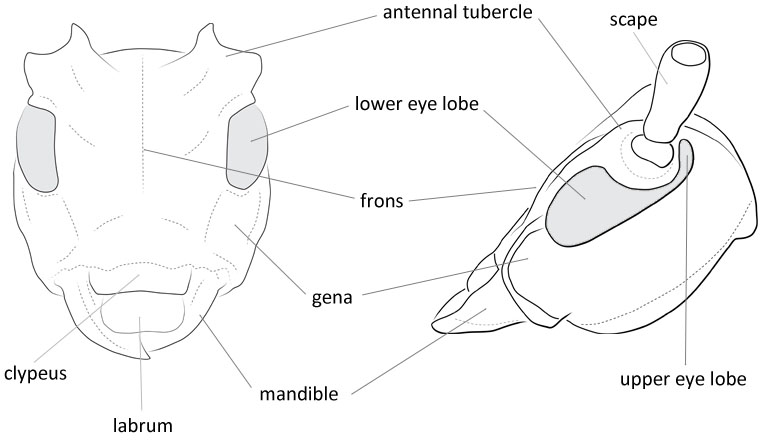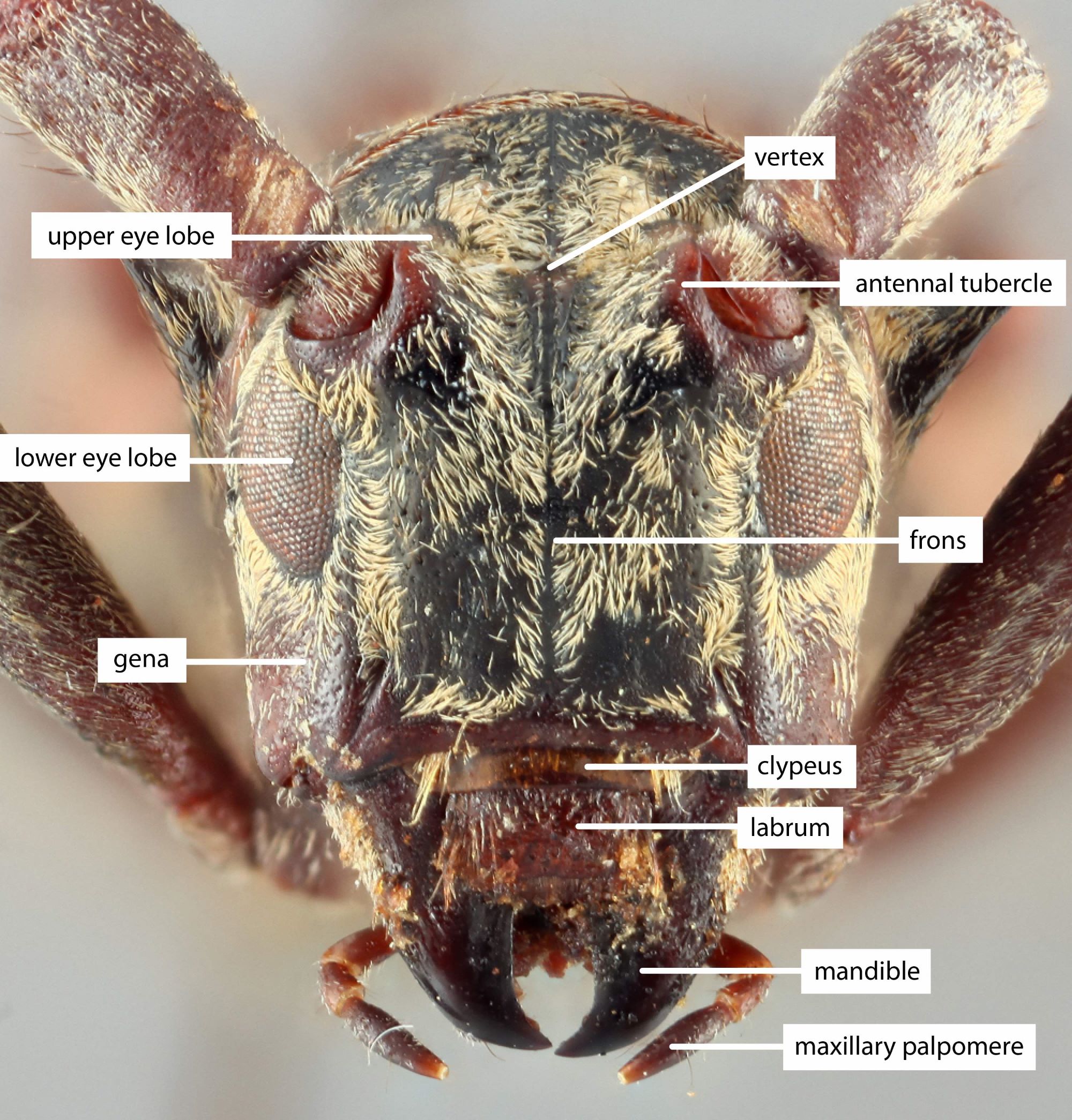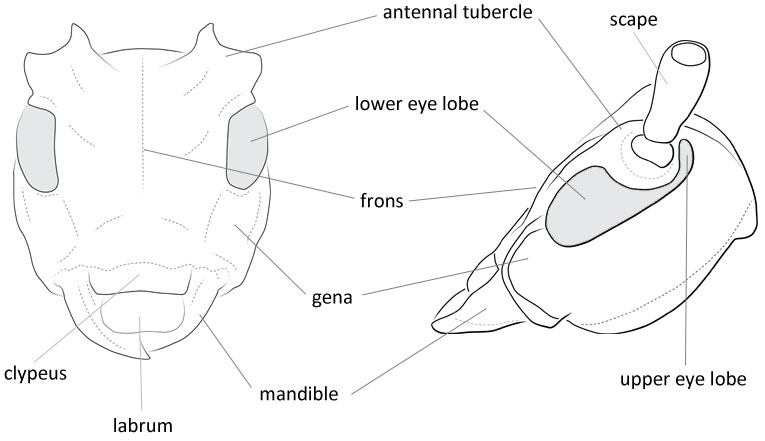Body length: 9–16 mm.
Eyes: eye interommatidial setaeseta:
a sclerotized hair-like projection of the cuticle
absent, eye entire/shallowly emarginateemarginate:
notched at the margin , rarely deeply emarginateemarginate:
, rarely deeply emarginateemarginate:
notched at the margin > half width, eye ommatidial density fine.
> half width, eye ommatidial density fine.
Antennaeantenna:
in larval and adult insects, paired segmented appendages, borne one on each side of the head, functioning as sense organs and bearing a large number of sensilla
: antennal length reaches between basebase:
the part of any appendage or structure that is nearest the body
and end of elytraelytron:
the leathery forewing of beetles, serving as a covering for the hind wings, commonly meeting opposite elytron in a straight line down the middle of the dorsum in repose
, rarely reaching/surpassing end of body, antennal flagellar segments elongateelongate:
much longer than wide
, scapescape:
the first proximal segment of the antenna smooth/punctate at apexapex:
smooth/punctate at apexapex:
end of any structure distad to the base
, antennal scapescape:
the first proximal segment of the antenna ≥ segment 3 or segment 3 > scapescape:
≥ segment 3 or segment 3 > scapescape:
the first proximal segment of the antenna .
.
Pronotumpronotum:
the upper and dorsal part of the prothorax
: pronotumpronotum:
the upper and dorsal part of the prothorax
shape longer than wide, pronotumpronotum:
the upper and dorsal part of the prothorax
lateral armature absent.
Prosternum: prosternal processprosternal process:
a posterior extension of the prosternum between the coxae dilated at apexapex:
dilated at apexapex:
end of any structure distad to the base
, procoxal cavities open posteriorly.
Elytraelytron:
the leathery forewing of beetles, serving as a covering for the hind wings, commonly meeting opposite elytron in a straight line down the middle of the dorsum in repose
: elytral length reaching or close to end of abdomen, elytral apicesapex:
end of any structure distad to the base
emarginate, with tooth or spinespine:
a protuberance with an acute (sharp) distal end
, rarely rounded or truncatetruncate:
cut off squarely at the tip
, elytral color black, reddish or orange, elytral color pattern present or absent.
Legs: visible tarsomerestarsomere:
subdivision or article of the tarsus, usually numbering from two to five : 4, femora slender, protibial spursprotibial spur:
: 4, femora slender, protibial spursprotibial spur:
sclerotized spine(s) located at the distal tibia; can be single, double, or absent : 2, tarsal clawstarsal claw:
: 2, tarsal clawstarsal claw:
usually paired claws of the pretarsus, at the distal end of the leg simple.
simple.
Form moderate sized, tapering posteriorly. Head oblique, front short; tempora moderate, parallel, abruptly constricted behind; palpi unequal, slender; vertexvertex:
the top of the head between the eyes, frons and occiput, anterior to the occipital suture broad, almost plane; eyes finely faceted, notched; antennaeantenna:
broad, almost plane; eyes finely faceted, notched; antennaeantenna:
in larval and adult insects, paired segmented appendages, borne one on each side of the head, functioning as sense organs and bearing a large number of sensilla
slender, inserted on front near top of lower eye lobeeye lobe:
used to refer to the upper or lower portion when the eye is emarginate or separated , outer segments slightly expanded at apicesapex:
, outer segments slightly expanded at apicesapex:
end of any structure distad to the base
, especially in males, third segment subequal to first, fourth shorter than third, fifth equal to or longer than third, poriferous areas absent. Pronotumpronotum:
the upper and dorsal part of the prothorax
longer than broad, subcylindrical, hind angles rounded; apexapex:
end of any structure distad to the base
slightly narrowing, barely impressed; basebase:
the part of any appendage or structure that is nearest the body
shallowly impressed across disk; disk weakly convex, not impressed longitudinally; prosternum narrowly impressed at apexapex:
end of any structure distad to the base
, coxal cavities closed behind; mesosternal processmesosternal process:
a prolongation of the mesosternum extending between the mesocoxae
almost flat, lying below tops of coxae. Elytraelytron:
the leathery forewing of beetles, serving as a covering for the hind wings, commonly meeting opposite elytron in a straight line down the middle of the dorsum in repose
slightly dehiscent at apicesapex:
end of any structure distad to the base
; usually opaque in females; apicesapex:
end of any structure distad to the base
truncate, usually unarmed; Wings without a closed cell in anal sector. Legs slender; posterior tarsitarsus:
the leg segment distal to the apex of the tibia, bearing the pretarsus; consists of one to five tarsomeres (including pretarsus)
slender, at least as long as hind femora, first segment as long as following segments together, third segment not cleft beyond middle. Abdomen normally segmented (Chemsak 2005Chemsak 2005:
Chemsak JA. 2005. Illustrated Revision of the Cerambycidae of North America. Volume II. Lepturinae. Wolfsgarden Press, Chino, CA: i–xv + 1–446, 27 pls.).
This genus is characterized by the subcylindrical, weakly convex, and shallowly impressed pronotumpronotum:
the upper and dorsal part of the prothorax
. The very short face, the subparallel tempora, and the weakly subserrate antennaeantenna:
in larval and adult insects, paired segmented appendages, borne one on each side of the head, functioning as sense organs and bearing a large number of sensilla
are also distinctive (Chemsak 2005Chemsak 2005:
Chemsak JA. 2005. Illustrated Revision of the Cerambycidae of North America. Volume II. Lepturinae. Wolfsgarden Press, Chino, CA: i–xv + 1–446, 27 pls.).
Palearctic, Nearctic, Neotropical
Abies, Picea, Pinus, Larix, Pseudotsuga, Tsuga; Juniperus; broadleaf trees
13 species and 5 more sspp. All species seem to occur on conifers but some also will develop in broadleaf trees.
Marthaleptura Ohbayashi, 1963
Strangalia (Anastrangalia) Casey, 1924